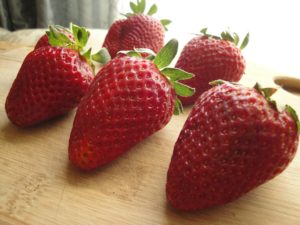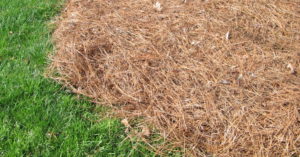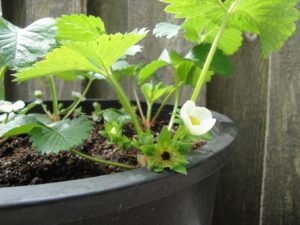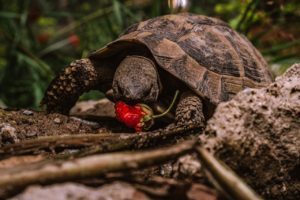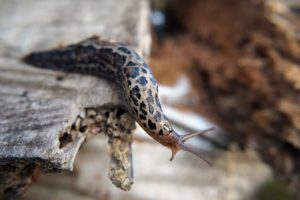Page 2
The Harvest
Although the fruits might look as though they’re ready for picking, give them another day or two to ripen on the plants for full, sweet flavor. They won’t continue to ripen after they’ve been cut.
When harvesting strawberries, snap or snip the stem above the sepals, the green cap on top of the fruit. Pulling the fruits can damage them, causing a rapid decline. Handle carefully to prevent bruising.
Keep the fruits cool, in the refrigerator. Avoid rinsing them because water on the surface of the fruits can initiate mold in storage. Dirty berries should be cleaned, though, but dry them before storing.
Renovating the Strawberry Bed
If you’ve had a dry period, water the bed before the renovation, applying about an inch of water.
Immediately after the last harvest, raise the mower deck, and mow down the bed to 1″ above the crowns. You also can cut back the clumps using hand tools. Remove all clippings from the bed to prevent diseases or insects from remaining in the garden.
Tightly matted crowns need to be thinned. Remove excess plants so the remaining crowns are 6″ apart. In addition to thinning, remove plants at the edges of the beds to narrow the growth to 12″ to 18″ wide.
After renovating the bed, fertilize with 10-10-10 or 20-20-20 and water it in. Avoid letting granules land in the crowns. Organic growers often use blood meal and bone meal monthly during the summer. Plants will grow new foliage and set flower buds later in the season for next year’s crop. But new growth emerging late in the season probably will be damaged by the cold.
With good care, strawberry plants should last 3 or 4 years.
Varieties
In North Carolina, the favorite varieties, according to the North Carolina Strawberry Association, are ‘Chandler’ in cooler regions of the mountains and the piedmont, and ‘Camarosa’ in the eastern part of the state. Also mentioned for growing here are ‘Albion’, ‘Bish’, ‘Gaviota’, ‘Gem Star’, ‘Oso Grande’, ‘Seascape’, ‘Strawberry Festival’, ‘Sweet Charlie’, ‘Treasure’, and ‘Ventana’.
Check out ‘Earliglow’, ‘Elan’, ‘Galletta’, ‘Honeoye’, ‘Jewel’, ‘Ozark Beauty’, ‘Sparkle’, ‘Toscana’, ‘Tribute’, and ‘Tristan’. Strawberry seeds are available for some varieties, but most gardeners grow them from bare root stock or potted plants.
New varieties are coming to the market as demand grows for nutrient-dense fruits. There are some novel strawberries, such as ‘White Pineberry’, with red-spotted white fruits which taste like pineapple. Strawberries, Fragaria x ananassa, reminded early breeders of the taste of pineapple (Ananas comosus), a correlation which is reflected in the botanical names for these plants.
In 2012, Cornell University introduced a smaller variety with solid purple fruits. Burpee sells this one, called ‘Purple Wonder’. It was in development for 13 years and is not a GMO. (I assume the deeper color throughout the fruit indicates the presence of more anthocyanins, and, therefore, more antioxidants.)
Strawberries are nutritious little fruits, with high levels of antioxidants, Vitamins C and K, folate, manganese, potassium, and fiber. Curiously, the power of most berries’ beneficial antioxidants is cancelled when combined with dairy products, especially high-fat dairy. So, eat a few of them by themselves for a snack. Adding more berries to your breakfast cereal, however, will begin to raise the available antioxidant content.
Winter Protection
In cold climates, cover your strawberry beds with several inches of an airy mulch, such as straw or pine needles, after the soil begins to freeze. This will protect dormant flower buds over the coming months.
Pull most of the mulch aside in late winter or spring, and the plants will soon open their white flowers. Some varieties have pink or red blooms. A hard frost will kill the flowers, though, so be prepared to cover the plants at night if you don’t want to lose the crop. This is especially important for June-bearing strawberries.
Reemay and other row covers are finely woven lightweight fabrics that can protect strawberries from several degrees of frost.
Potted Strawberries
Because strawberries grow only 8″ to 12″ tall, it would not be difficult to grow them in containers. I recommend everbearing or day-neutral varieties for measured harvests through the season. The vigorous June-bearers might quickly get out of hand, but if you want to try them, go for it. Some varieties are specifically recommended for containers as well as for gardens. You could try growing them in its namesake, the strawberry jar.
When growing strawberries in pots, look for varieties rated 1 or 2 zones colder than your location. Roots above the ground are exposed to cold air temperatures and are not insulated by surrounding soil. So, if you live in USDA zone 6, choose varieties that are hardy in zone 4 or 5 if you intend to overwinter them for the following year. That helps, but mulch them, too.
The Pots and Potting Soil
Use pots that are only about 10″ deep. I’ve seen them growing in repurposed gutters, but they must be carefully monitored for soil moisture. Pots must have drainage holes. Strawberries are shallow rooted, so you might need to add extra drainage material (pine fines, coarse perlite) mixed into the soil if using large pots. Good quality potting soil should suffice, with extra compost mixed in.
Adding gravel in the bottom of the planter will not improve drainage. In fact, it could impede drainage as the water does not readily move from a medium with small air pore space between the particles (the soil) into a medium with large air pore space (the gravel). Water sits at the perched water table, saturating soil right above the gravel and rotting the roots.
Window boxes or long narrow planters could work well. Some have built-in reservoirs that let the soil absorb moisture as needed…until it’s gone. So, check it daily. If the reservoir retains water for a few days, mosquitoes could become a problem. Solution: add a piece of Mosquito Dunks to the reservoir to kill the wrigglers or tilt the pot to drain the excess.
Light-colored containers will not overheat the soil as much as dark pots. Or place small plants, such as annuals or potted herbs, on the sunny side of the strawberries to shade their roots.
Ripening fruits will hang over the sides. Foliage is open to the air on all sides, helping to keep diseases in check. Potted plants on carts can be shifted around the deck as the sun moves. Still, watch out for hungry squirrels and birds.
Watering the Containers
Potted crops might need daily watering once they’re in full foliage. Use cool water, preferably in the morning, and mulch the soil to conserve moisture. Water thoroughly, letting the excess drain away. Installing drip irrigation will deliver the water where it’s needed—in the soil—instead on the leaves, where diseases begin.
At the end of the growing season, move the planters where they won’t be exposed to winter’s harshest realities. An unheated shed or garage, or under a carport next to the house could be good spots, after they’ve gone fully dormant. Maybe you could place them on the south side of the house, and pile leaves and evergreen boughs around and over the containers. Check the soil periodically for moisture, and keep them cold enough so they don’t start growing prematurely.
Maintain potted strawberries following practices described in this article for garden plantings. I recommend refreshing the soil and dividing the crowns every year, and fertilizing monthly during the growing season.
I transplanted 4 ‘Ozark Beauty’ strawberries (photo, above) into a 12″ container, and they’ve already formed flower buds. That’s an everbearing variety, and was the only one available the day I visited the garden center. Yes, I’m supposed to remove these first flowers…but… (***Update***: So far, I’ve harvested about 10 fruits, although they were undersized. Absolutely delicious, though! 5/8/21)
Problems?
I can’t promise trouble-free strawberry growing. These plants are related to roses, after all. But you’ll have fewer problems with good sanitation and proper growing conditions. Planting disease resistant varieties is a good start. Your local agricultural extension office has information needed for a successful crop. Johnny’s Selected Seeds offers several organic remedies for insects and diseases.
Air circulation, keeping the foliage dry, thinning, and not planting in dry or compacted soil will eliminate some of the conditions that stress plants. Monitoring the plants for diseases and insects, and acting quickly, might thwart their spread.
Remove dead and yellowed leaves and overripe fruits from the garden. Weeds growing in or near the strawberry beds provide shelter for overwintering pests, so keep the area clear.
Cover the ripening fruits with bird netting or stronger wire barriers to prevent animals from stealing your crops. Many animals like strawberries—birds, squirrels, deer, chipmunks, woodchucks, insects, slugs, and even turtles! Check the netting daily to make sure birds or snakes haven’t become entangled in it.
Insects and Mites
There are several insects and a couple of mites that might attack leaves, flowers, roots, or fruits. They include crickets, cutworms, cyclamen mites, two-spotted mites, aphids, spittlebugs, sap beetles, tarnished plant bugs, whiteflies, and certain weevils and beetles.
Sometimes, a strong splash of cool water from the hose will solve some of the problems. Bt, Bacillus thuringiensis, is an effective organic remedy for larvae of moths and butterflies. And horticultural oil will suffocate the others, if it reaches them. This website from the University of Kentucky has photographs and detailed information on the life cycles of strawberry pests.
Slugs and Snails
Deep holes gouged into ripe fruits are usually a sign that slugs and snails have been dining in your garden.
I’ve had good results with organic Sluggo around the vegetable gardens. Look for the organic option (read the label). It’s iron phosphate, which breaks down in the soil and will be used by plants. Sprinkle a few granules close to crops during wet weather, which is when slugs are seen in huge numbers.
Another remedy for these mollusks is to place boards on damp soil around the garden. In the morning, take an old knife with you as you inspect what might be resting underneath. Normally, they feed in the cool dampness of the night and seek shelter by morning. You’ll see dozens of slugs and snails, perhaps fewer in dry weather. (But you’re not letting the strawberries go too dry, right?) Use the knife to dispense with them quickly and finally. Never use salt in the garden.
Copper tape secured around raised beds or the sides of pots deters these pests by shocking them as they attempt to slime over it. But make sure leaves or runners aren’t creating a bridge over the copper.
Empty citrus rinds placed upside down at the edge of the bed might attract slugs. Check them early in the morning.
Diseases
Yes, that can happen, too: Phytophthora crown or root rot, Verticillium wilt, Rhizoctonia, powdery mildew, Anthracnose fruit rot, Botrytis mold, leaf spot diseases.
I prefer to grow strawberries cleanly rather than spray for diseases and every little thieving critter. Strawberries often top the list of notorious “Dirty Dozen” crops, those which have the highest amounts of pesticide residue.
Careful variety selection, favorable weather, and attention to growing practices will decrease the chances that your strawberry garden will fall prey to disease. There are remedies, both organic and non-organic, but don’t delay the treatment.
Celebrate!
After working so hard in your strawberry patch, celebrate with a bowl of strawberries and cream, now a Wimbledon tradition. This combination of wild strawberries and cream is credited to Cardinal Thomas Wolsey, in the early 1500’s, and his Hampton Court kitchens. At the time, Wolsey served as Lord Chancellor to England’s King Henry VIII, before he was forced to hand over the palace keys, in 1529, to King Henry for failing to enable the king’s divorce from Catherine of Aragon.
Here’s a fascinating read on the origins of today’s fruitful strawberries. This 300-year-old story involves a French spy/engineer named Amadée François Frézier, South American farmers, 17-year-old Antoine Nicholas Duchesne, and King Louis XV. Throw in the chance pairing of strawberry species by farmers in Brest, France, et voilà, we have strawberries.
For total immersion in all things strawberry, see if a community near you sponsors a Strawberry Festival. Good luck with your new strawberry garden!
Headings
Page 1: Types of Strawberries (June-Bearing, Everbearing, Day-Neutral, Alpine), Preparing the Bed for Strawberries (How To Configure the Beds, The Matted Row System, The Hill or Mounded System, Dig In!), Planting the Strawberries, Mulch, and In Their First Year (Pollination)
Page 2: The Harvest, Renovating the Strawberry Bed, Varieties, Winter Protection, Potted Strawberries (The Pots and Potting Soil, Watering the Containers), Problems? (Insects and Mites, Slugs and Snails, Diseases), and Celebrate!
